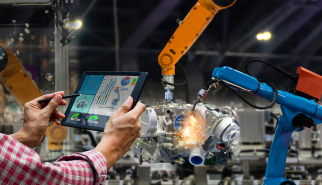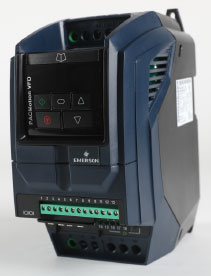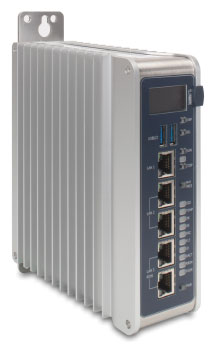- By Rich Carpenter
- January 30, 2020
- Discrete Mfg & Machine Control
Summary
Fast Forward
- Data analytics provide valuable feedback to optimize maintenance, increase uptime, and improve real-time control.
- Industrial data sources include sensors, controllers, and smart devices at the operating edge, so it makes sense to collect, preprocess, and analyze data locally.
- Only transport data as appropriate to the cloud. Edge data can be analyzed locally to make better control decisions and then cleansed, transformed, and packaged for transmission to the cloud.
IIoT advanced computing happens on the factory floor

By Rich Carpenter
Discrete manufacturers and original equipment manufacturers (OEMs) are experts when it comes to operating their equipment. They run and develop these systems daily, always learning and improving. Once stable operation is established, these companies must proceed to incorporate technologies and methods, such as data analytics, to improve performance. Cloud-based analytics are an option, but many users have discovered it is expensive or against established information technology (IT) policy to move data for all analytics to the cloud.
Engineers and designers of manufacturing and OEM systems develop expertise integrating the right automation platforms to obtain the necessary functionality, even though this task may not be their core strength. They are aware of the need for good operating metrics and are looking for smart ways to add them to an already functional system.
A lot can be learned by observing a system in operation and obtaining user feedback. However, quantitative values, such as throughput rates, failure counts, change-over frequency, and other data, are usually needed to support more in-depth analysis. Automating the data gathering process is the most effective way to obtain enough source information for analyzing how a system is running and where it can be improved.
The need for improved operations, coupled with emerging types of powerful edge components, is driving more data processing, and sometimes analytics, to be performed at the edge. Where appropriate, the results may also be sent to the cloud for comparison across multiple plants or for OEMs who have equipment distributed across a diverse customer base. This article addresses the value of analytics for industrial manufacturing applications and compares edge processing solutions.
What are analytics?
Analytics projects require the historization of vast amounts of raw data, but this alone does not create business value. Instead, such value is only realized through better comprehension of how a system is currently running and how it could operate better. Analytics are any evaluation of raw data to improve it into useful information, which in turn can give users insights to help them increase throughput, improve quality, and optimize maintenance.
Acting based on analytics results may be a procedural activity initiated by engineers or operators. In some cases, it is now possible to directly and programmatically use analytical results to inform control platforms about improved operating parameters.
Programs for applying analytical methods can operate in many locations. They may run on edge-located controllers, on site-located systems, or in the cloud. Some analytics projects may operate in two or all three of these locations.
Edge data sources
Part of the reason analytics are becoming more relevant is due to the increasing richness of available data. For manufacturing and machine control applications, the data needed to support analytics can come from any sort of edge-located basic sensor, smart sensor, smart instrument, digital device, or more complex local system. Collectively, increasingly intelligent edge-located sensors and devices are generally known as Industrial Internet of Things (IIoT) devices.
A simple photo eye can indicate how many times a machine cycles or a part is produced. Instruments monitor pressures, flows, and power consumption. Smarter subsystems may calculate uptime, energy use, and quality parameters. Smart manifolds offer early indication of air leakage, which leads to excess energy consumption and higher operating costs. There are many other examples of smart edge devices like variable speed drives (VFDs), analyzers, power meters, and intelligent valve controllers (figure 1).
All of these may provide multiple data streams using conventional wiring and networked signals or newer wireless connections. The data typically includes one or more near-real-time process variables, and other less-real-time extended configuration and diagnostic information.
In addition, data sources can include less traditional digital sources like the Internet and company intranets, which have information relevant to production processes, such as raw material prices, energy prices, weather conditions, and demand for finished products. Gathering the data effectively calls for installing the right technologies in the right locations to obtaining it from many types of sources on varying time scales.

Importance of edge processing and analytics
In recent years, there has been an emphasis on cloud computing, which is a good method for aggregating many sources of data. However, for many plant-level data analytics needs, the cloud-only method is not usually the best solution. There are examples of predictive maintenance performed on high-value equipment using data sampling techniques at the edge to provide early warning signs of failing equipment.
The edge of any industrial system is the natural place to begin an analytics initiative because that is where the source data is created. Many data points may be involved, and each point can potentially have a high sample rate. Common sense informs us it might be burdensome and perhaps costly to transmit all this data to the cloud. Edge-located preprocessing of the raw data refines it into more concise values.
Traditional analytics were based on data obtained mainly from equipment control systems, because those digital systems were already connected to the sensors for command and control. Furthermore, the computing resources needed for storing data and analyzing it were only available at the server or perhaps desktop computer level.
Today, many end users are embarking on IIoT initiatives and taking advantage of IIoT devices to obtain rich new data streams, economically bypassing traditional control systems. A new generation of edge-capable components are best suited to interface with the growing number of IIoT data sources and can offer many benefits for processing and analyzing this data closer to the edge.
Edge analytics advantages
Due in part to the growing capability of industrialized hardware and associated software, it is more practical than ever to perform advanced computing at the factory floor with a range of edge-capable component options (figure 2). Some advantages of edge analytics are:
- improved data privacy
- better data fidelity and responsiveness
- resilience against data transmission interruptions
- reduced data communications
- a better opportunity to “close the loop” for control
Many companies are rightfully concerned with data privacy. Data obtained at the edge and analyzed at the edge is easier to secure, generally because it is kept local. Even if the data must be transported to analytics applications located elsewhere onsite, or in the cloud, the latest edge controllers and devices use modern and secure IT-based protocols for communicating.
Data generated using traditional operational technology–based devices, most commonly programmable logic controllers (PLCs), may lack security measures or may have added-on security instead of built-in security. Conventional systems can be preserved and interfaced by edge computing devices. They can secure them, perform analytics, and provide upstream connectivity.
Another important reason to move analytics to the edge is because the data source is closer to the processing, providing near-real-time fidelity and responsiveness with minimal communications. Certain analytics require this performance.
Cloud-based analytics, on the other hand, must use data that is potentially time delayed by transmission, suffering from longer sample rates, and subject to transmission interruptions. Edge-based analytics avoid most of these issues.
Even when data must be transferred to higher-level systems, edge analytical results may be a much smaller data set than the entire amount of source data points. Moving data, especially at high resolution, and cloud storage for large amounts of data, can be cost prohibitive.
Edge analytics have also enabled a much better solution for “closed-loop” operations by directly applying results to an operating process without requiring operator intervention. Analytics performed closer to the edge, sometimes onboard the same component as the real-time controller, are more readily integrated back into the automation control platforms, without the many interposing communication layers involved with cloud-based solutions.

Ways to integrate edge analytics
As noted previously, PLCs conventionally have supplied much of the industrial edge data used for analysis. This is changing as IIoT devices are more widely incorporated, and because edge components are gaining better processing and networking capabilities.
The three leading edge components are controllers, devices, and gateways—each with varying capabilities for gathering, transmitting, and processing data for industrial systems. Edge controllers can perform extensive data preprocessing and run analytics applications, in addition to executing real-time control (figure 3). Edge devices may perform local analytics but are not involved in controlling equipment. Gateways perform little or no data preprocessing prior to transmission.
While each of these components plays a role, edge controllers are the most capable of the three. This new class of IIoT controller includes all the capabilities of edge devices and edge gateways, combined with the high-speed deterministic control features found in a typical PLC, including support of IEC 61131 languages.
The architecture of modern edge controllers includes support for open-source capabilities, allowing companies to rapidly incorporate IT-friendly languages, protocols, and concepts like Python, OPC UA, web servers, and databases. Edge controllers are analytic-friendly and can host third-party applications to help end users reach their analytics goals.
Edge controllers have the capability to run nondeterministic analytics or connect to a cloud infrastructure for additional information, and the unique ability to directly bring this information into the deterministic control scan in order to apply more informed decisions and optimize plant processes. This ability for connected equipment, like connected people, to make more intelligent decisions is driving a major transformation in the industrial space.
Users can install edge controllers in new greenfield applications, initially using them as PLCs but eventually expanding their role to include analytics. Or, edge controllers can be retrofit into brownfield systems to add analytical and IIoT capabilities.
Edge alternatives
Although edge controllers are the most complete option, other edge components like devices and gateways can be used as cost-effective alternatives or in conjunction with edge controllers in some applications. Edge devices typically support local applications with analytics on the device and can communicate data like an edge gateway. They are a good fit for use in conjunction with an existing control system that will remain in service, when it is desirable to add analytics capability.
An edge device might be used when the analytics require high-fidelity data, which can require too much network bandwidth to transfer to the cloud or where the cost of cloud systems and storage is too high to be practical. Because they are installed local to the source data, they are also a good approach when gaps in data collection due to network connectivity issues would otherwise significantly affect the quality of the analytics.
Edge gateways typically include protocol drivers to connect to plant controllers as well as cloud connectors to connect to leading cloud infrastructures such as Microsoft Azure and the Amazon IoT cloud. The purpose of the edge gateway is simply to collect data from industrial devices, package it, and send it to industrial clouds, whether public or private.

How companies are using edge analytics
Manufacturers and OEMs are learning how to implement edge analytics, and it is not an all-or-nothing proposition. They can start in just one targeted area, apply edge analytics concepts as supplementary to already-operating controls, or choose new platforms and use the available capabilities progressively as needed.
Edge gateways are typically used to get visibility to a geographically distributed set of assets. The edge gateway connects to the asset, packages the data, and transports the data to a cloud or hosted infrastructure. This consolidated data is often accessed in order to check the health of the equipment, avoiding the significant expense of travelling to each site.
Edge devices typically augment an on-premise machine or plant by collecting data from the device, aggregating it with other information available, and then analyzing this data to optimize control decisions. For example, the edge device may combine production data from a machine control system with data collected through supplementary sensors added outside of the control platform—such as for vibration, pressure, and temperature—and use this information in context to detect overall process problems and support a human-machine interface (HMI) (figure 4). This processing, for example, could observe an increase in air pressure required to manage machine motion, which could indicate leaks in the system.
An edge controller is more like a modern car, where the driver still performs direct control but is advised by an onboard navigation system as to the best route. A real-time operating system (RTOS) portion of the edge controller manages the deterministic control system, while a second general-purpose operating system (OS) side may be connected to IoT devices and broader information available from supervisory computing and even the Internet. The RTOS and the OS may constantly exchange information to optimize production processes. For example, the controller side may be managing reservoirs of water as they move through a purification process. The general-purpose side may be checking the forecasted energy prices and communicating to the control side the optimal time to run equipment for energy savings.
Start with analytics at the edge
End users are aware that analytics initiatives are an important avenue to better understanding, and therefore improvement, of their industrial systems. They also know there may be large quantities of untapped data in IoT sensors, smart field devices, and even existing OT systems. However, the idea of creating an overarching cloud-based system to take advantage of the data can be daunting.
The availability of powerful edge components enables another practical approach. Installing modern edge controllers and edge devices is a comparatively easy way to begin taking advantage of analytics. These edge components can perform the analytical role themselves or support future cloud-based systems.
There are many reasons to keep analytics close to the field, especially to obtain the best data fidelity and communications robustness. More compelling for some applications is the ability of edge controllers to close the loop by directly using analytical results to inform the real-time control system of optimal operational settings.
Reader Feedback
We want to hear from you! Please send us your comments and questions about this topic to InTechmagazine@isa.org.


